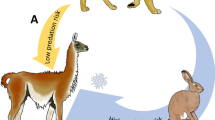Abstract
Because cannibals are potentially both predator and prey, the presence of conspecifics and alternative prey may act together to influence the rate at which cannibals prey upon each other or emigrate from a habitat patch. Wolf spiders (Lycosidae) are cannibalistic-generalist predators that hunt for prey with a sit-and-wait strategy characterized by changes in foraging site. Little information is available on how both prey abundance and the presence of conspecifics influence patch quality for these cursorial, non-web-building spiders. To address this question, laboratory experiments were conducted with spiderlings and older juveniles of the lycosid genus Schizocosa. The presence of insect prey consistently reduced rates of spider emigration when spiders were housed either alone or in groups. Solitary juvenile Schizocosa that had been recently collected from the field exhibited a median giving-up time (GUT) of 10 h in the absence of prey (Collembola); providing Collembola increased the median GUT to 64 h. For solitary spiders, the absence of prey increased by about fourfold the rate of emigration during the first 24 h. In contrast, for spiders in patches with a high density of conspecifics, the absence of prey increased the 24-h emigration rate by only 1.6-fold. For successful cannibals in the no-prey patches, the presence of conspecifics improved patch quality by providing a source of food. Mortality by cannibalism was affected by both prey availability and openness of the patch to net emigration. In patches with no net emigration, the presence of prey reduced rates of cannibalism from 79% to 57%. Spiders in patches open to emigration but not immigration experienced a rate of cannibalism (16%) that was independent of prey availability. The results of these experiments indicate that for a cannibalistic forager such as the wolf spider Schizocosa, (1) the presence of conspecifics can improve average patch quality when prey are absent, and (2) cannibalism has the potential to be a significant mortality factor under natural field conditions because cannibalism persisted in prey patches that were open to emigration.
Similar content being viewed by others
Author information
Authors and Affiliations
Additional information
Received: 12 April 1996 / Accepted: 14 August 1996
Rights and permissions
About this article
Cite this article
Wagner, J., Wise, D. Influence of prey availability and conspecifics on patch quality for a cannibalistic forager: laboratory experiments with the wolf spider Schizocosa . Oecologia 109, 474–482 (1997). https://doi.org/10.1007/s004420050107
Issue Date:
DOI: https://doi.org/10.1007/s004420050107




